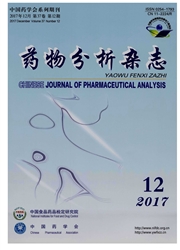

 中文摘要:
中文摘要:
目的:建立HPLC-MS/MS法同时测定山银花中7个有机酸(新绿原酸、绿原酸、隐绿原酸、咖啡酸、3,4-二-O-咖啡酰奎宁酸、3,5-二-O-咖啡酰奎宁酸和4,5-二-O-咖啡酰奎宁酸)的含量,并对其在3种不同植物来源的药材中的含量进行比较。方法:采用Shiseido Capcell Pak-C18色谱柱(4.6 mm×250 mm,5μm),以0.1%甲酸水溶液(A)-乙腈(B)为流动相,梯度洗脱,流速为1 mL·min^-1,加柱后分流器,使约30%洗脱液进入质谱仪,柱温30℃,进样量5μL;质谱采用ESI-多反应监测(MRM)模式扫描,以水杨酸为内标,脱溶剂温度350℃,脱溶剂气流(N_2)600 L·h^-1,雾化器压力0.2 MPa,毛细管电压4 kV。结果:新绿原酸、绿原酸、隐绿原酸、咖啡酸、3,4-二-O-咖啡酰奎宁酸、3,5-二-O-咖啡酰奎宁酸和4,5-二-O-咖啡酰奎宁酸质量浓度分别在0.032-32.224μg·mL^-1(R^2=0.999 5)、0.168-16.800μg·mL^-1(R^2=0.999 4)、0.038-15.104μg·mL^-1(R^2=0.999 8)、0.010-4.064μg·mL^-1(R^2=0.999 2)、0.013-5.372μg·mL^-1(R^2=0.999 5)、0.079-39.840μg·mL-(-1)(R^2=0.999 5)和0.041-16.208μg·mL^-1(R^2=0.999 3)范围内线性关系良好;定量限(LOQ)为10.0-19.9 ng·mL^-1,平均回收率在94.01%和105.0%之间。样品测定结果显示,山银花中绿原酸和3,5-二-O-咖啡酰奎宁酸含量较高,分别为1.262%-7.408%和0.636%-4.803%;咖啡酸含量较低,为0.003%-0.022%。通过比较不同植物来源的样品,发现其在有机酸的含量和比例方面存在较大差异。结论:本实验建立的方法灵敏、准确,可用于山银花药材中有机酸的含量测定,测定结果可为该药材质量标准的完善提供依据。
 英文摘要:
英文摘要:
Objective: To establish a method for simultaneous determination of seven organic acids ( neochlorogenic acid, chlorogenic acid, cryptochlorogenic acid, eaffeie acid, 3,4-di-O-caffeoylquinic acid, 3,5-di-O-caffeoylquinic acid and 4, 5-di-O-caffeoylquinic acid ) in batches of Lonicerae Flos samples, and to compare their contents in the samples from different origins. Methods: Chromatographic separation was performed on a Shiseido Capcell Pak-C18 column ( 4.6 mm × 250 mm, 5 μm ) at 30℃ of column temperature. 0.1% aqueous formic acid ( A ) and acetonitrile ( B ) were adopted as mobile phase with a gradient elution. The flow rate was set at 1 mL· min^-1, allowing approximately 30% eluent to be injected into the mass spectrometer by a post-column distributor. The injection volume was 5μ L. Detection was carried out on a triple quadrupole mass spectrometer in the negative ion mode using an electrospray source. Multiple reaction monitoring ( MRM ) mode was employed. Salicylic acid was used as internal standard ( IS ). The operating conditions were as follows : desolvation temperature, 350℃ ; desolvation gas N2 flow, 600 L· h^-1; nebulizer pressure, 0.2 MPa; capillary voltage, 4 kV. Results: The developed method showed good linearity in the range of 0. 032-32. 224 μg· mL^-1 ( R^2=0. 999 5 ) for neochlorogenic acid, 0. 168-16. 800 μ g· mL^-1( R^2=0. 999 4 )for chlorogenic acid, 0. 038-15. 104 μ g· mL^-1 ( R^2=0. 999 8 )for cryptochlorogenic acid, 0. 010-4. 064 μ g· mL^-1 ( R^2=0. 999 2 ) for caffeic acid, 0. 013-5. 372 μg· mL^-1 ( R^2= 0. 999 5 ) for 3,4-di-O-caffeoylquinic acid, 0. 079-39. 840 μg· mL^-1 ( R2=0. 999 5 ) for 3,5-di-O-caffeoylquinic acid, and 0. 041-16. 208 μg· mL^-1 ( R2=0. 999 3 ) for 4, 5-di-O-caffeoylquinic acid, respectively. The limits of quantification ( LOQs )ranged from 10.0 to 9.9 ng· mL^-1. The recoveries varied between 94.01% and 105.0%. Chlorogenic acid ( 1. 262%-7. 408% ) and 3, 5-di-O-caffeoylquinic
 同期刊论文项目
同期刊论文项目
 同项目期刊论文
同项目期刊论文
 期刊信息
期刊信息
